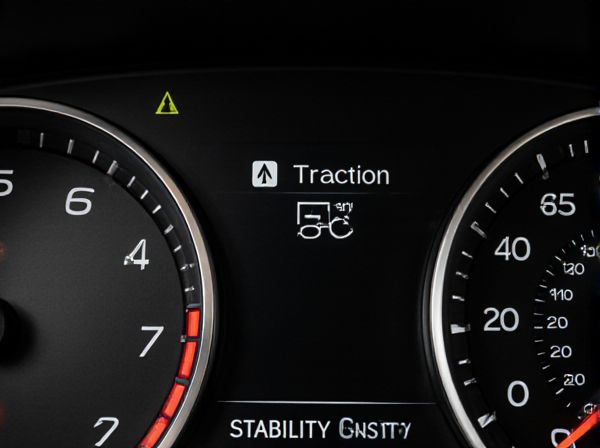
Photo illustration: Traction Control Warning vs Stability Control Warning
Traction control warning indicates a problem with your vehicle's system designed to prevent wheel spin during acceleration, while stability control warning refers to issues with the system that helps maintain vehicle stability during turns or sudden maneuvers. Both warnings signal potential safety risks and should be addressed promptly to ensure optimal driving performance. Ignoring these alerts can compromise your control over the vehicle in challenging road conditions.
Table of Comparison
| Feature | Traction Control Warning | Stability Control Warning |
|---|---|---|
| Purpose | Indicates loss of traction on driven wheels | Indicates vehicle stability system activation |
| Function | Improves grip during acceleration | Prevents skidding and loss of control |
| Common Causes | Slippery roads, wheel spin | Oversteering, understeering, sudden maneuvers |
| Dashboard Icon | Car with squiggly lines under tires | Car with curved skid marks icon |
| Driver Action | Reduce acceleration and drive cautiously | Ease steering and reduce speed immediately |
| System Type | Traction Control System (TCS) | Electronic Stability Control (ESC) |
Understanding Traction Control Warning
The Traction Control Warning indicates issues within the vehicle's traction control system, which helps prevent wheel spin during acceleration by adjusting engine power and braking force. This system is critical for maintaining grip on slippery or uneven surfaces, enhancing vehicle safety and performance. Recognizing a Traction Control Warning early ensures timely diagnosis and repair, preventing further traction loss and potential driving hazards.
What Triggers a Stability Control Warning?
A Stability Control Warning is triggered when the vehicle's electronic stability control (ESC) system detects a loss of traction or an imbalance in wheel speed, indicating potential skidding or sliding. Sensors monitor wheel rotation, steering angle, and lateral acceleration to identify when the vehicle's direction deviates from driver input, activating the warning to enhance safety. This warning helps prevent loss of control by alerting the driver and engaging brakes or adjusting engine power automatically.
Key Differences: Traction vs Stability Control
Traction Control Warning indicates a loss of grip on individual driven wheels, activating systems to prevent wheel spin during acceleration. Stability Control Warning signals the vehicle's electronic stability control system is engaged, managing overall vehicle balance by applying brakes to specific wheels and adjusting engine power to maintain directional control. The key difference lies in Traction Control managing wheel slip primarily during acceleration, while Stability Control maintains overall vehicle stability during cornering or sudden maneuvers.
Common Causes for Warning Lights
Traction Control Warning and Stability Control Warning lights commonly illuminate due to sensor failures, such as faulty wheel speed sensors or steering angle sensors, which disrupt the vehicle's ability to monitor traction and stability accurately. Other frequent causes include damaged wiring or connectors, low brake fluid levels, and issues with the ABS system that impact both traction and stability control functions. Regular diagnostic scans often reveal these underlying issues, helping to address warning light triggers promptly and maintain optimal vehicle safety systems.
How Systems Operate: Traction Control
Traction control systems operate by detecting wheel slip during acceleration and selectively applying brake force or reducing engine power to maintain optimal tire grip. Sensors constantly monitor wheel speed and vehicle dynamics, allowing the system to adjust torque output and prevent loss of traction on slippery surfaces. In contrast, stability control systems manage overall vehicle stability by intervening in both steering and braking to counteract understeer or oversteer during cornering.
Breaking Down Stability Control Function
Traction control warning signals indicate reduced grip on slippery surfaces by regulating wheel spin, while stability control warning alerts drivers to potential vehicle skidding or loss of control. Stability control functions by continuously monitoring steering angle, lateral acceleration, and wheel speed sensors to intervene through brake application on individual wheels and engine power reduction, enhancing vehicle stability during sudden maneuvers. Understanding these distinct warnings helps drivers recognize specific traction limitations versus overall vehicle stability issues, promoting safer driving responses.
Driving Safety Implications
Traction Control Warning indicates a loss of tire grip, alerting drivers to potential wheel spin on slippery surfaces, which can compromise acceleration and vehicle control. Stability Control Warning signals a malfunction in the vehicle's Electronic Stability Control system, critical for preventing skidding and rollovers during sharp turns or sudden maneuvers. Both warnings directly affect driving safety by reducing the vehicle's ability to maintain traction and stability, increasing the risk of accidents in adverse driving conditions.
Dashboard Warning Symbols Explained
The Traction Control Warning symbol indicates a problem with the vehicle's traction control system, which helps prevent wheel slip during acceleration. The Stability Control Warning light signals an issue with the electronic stability control system designed to maintain vehicle stability during cornering or sudden maneuvers. Understanding these dashboard warning symbols helps drivers identify and address safety system malfunctions promptly to ensure optimal vehicle handling and safety.
Troubleshooting Warning Light Issues
Traction Control Warning and Stability Control Warning lights often indicate issues within a vehicle's electronic stability systems, signaling sensor faults, ABS malfunctions, or degraded wheel speed sensors. Troubleshooting begins by scanning the vehicle's OBD-II system to identify diagnostic trouble codes, followed by inspecting wiring connections and sensor conditions for corrosion or damage. Resetting the control modules after repairs and testing during varied driving conditions ensures the warning lights have been resolved effectively.
When to Seek Professional Diagnosis
Traction Control Warning and Stability Control Warning lights indicate potential issues with vehicle safety systems designed to maintain control during slippery or challenging driving conditions. When either warning light persists after multiple restarts or appears alongside unusual vehicle behavior like slipping or loss of control, a professional diagnosis is essential to prevent compromised driving safety. Ignoring these warnings can lead to reduced braking efficiency and increased risk of accidents, making timely inspection by a qualified mechanic critical.
 caratoz.com
caratoz.com